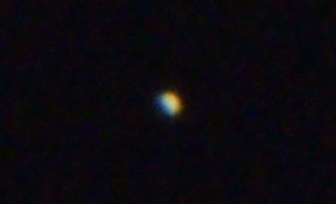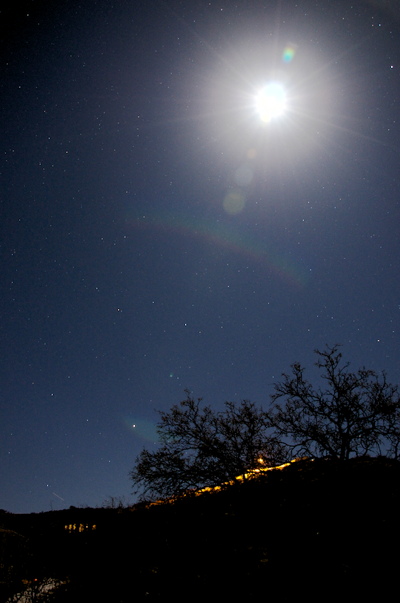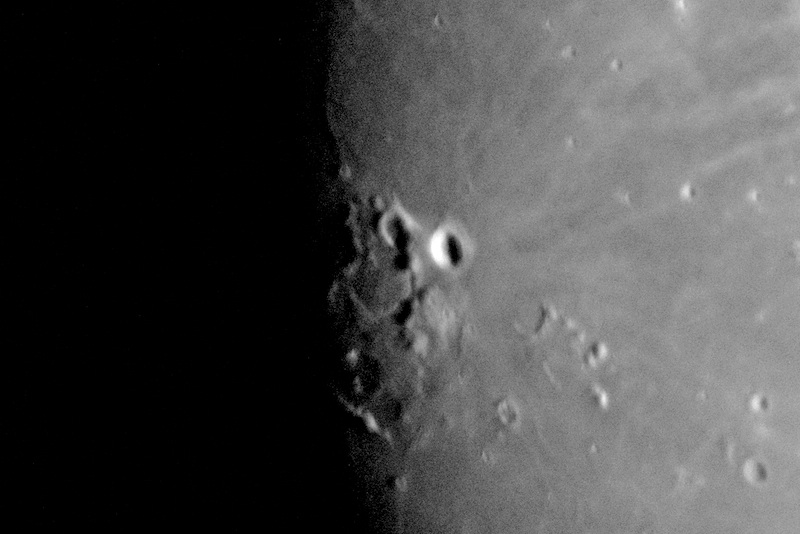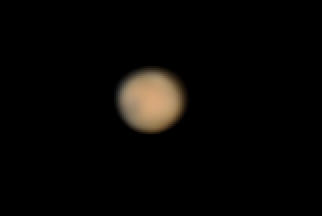
Imaging: Venus, Sunset, Mercury, Moon, Mars
Posted: 5 March 2012
I opened the observatory Sunday, 4 March 2012, at 1740 MST, 81°F. The sky was mostly clear and for a change, there was no wind or breeze blowing. The forecast was for clear skies but there were some clouds low in the southwest. I added some "acorn nuts" to the cut bolts on my new homemade "POD Roller Desk". No more sharp edges. Plus it looks nicer now.
At 1755 MST, viewed Venus, 77X and 206X. I took this cropped image of Venus, D7000 DSLR, 8" LX200-ACF, prime focus + 3X TeleXtender, 1/500sec, ISO 1600:

I then left the observatory to video record the setting sun in the hopes of capturing the "green flash". I have seen it from here but never tried to photograph it. On my way to slightly higher ground, I took this photo of a nesting bird:

As the sun set, I video recorded it with the D7000 DSLR, auto-exposure shutter speed, ISO 1600, 300mm. Due to the clouds I wasn't able to capture the green flash. But it still made a pretty sunset, as seen in this frame from the video:

I then took this photograph of Cassiopeia Observatory, with Kitt Peak Observatory on top of the mountain in the distance:

The waxing gibbous moon was photographed with the D7000 DSLR at f/11, 1/250sec, ISO 200, 300mm:

I returned to the observatory and did a D7000 DSLR video recording of Mercury, 1/200sec, ISO 5000. Unfortunately, it was too low in the sky now for good imaging. But a cropped frame from the video shows the phase:

I then began preparations for the upcoming ISS pass. Slewed to the moon for a focus test. This is prime focus, 1/2000sec, ISO 2500:

I updated the ISS TLE, added the 2X Barlow Lens, and did a focus on the moon, 1/2000, ISO 3200. Unfortunately, the image was underexposed. I did a finderscope alignment check using Venus. I then began waiting for the ISS pass to begin. Tracking was not very good this night, and unfortunately, the exposure settings resulted in a video that was too underexposed at prime focus + 2X Barlow Lens. So no images of the ISS this night. I will go back to just prime focus imaging on a future pass.
At 1916 MST, viewed Jupiter and its four moons, 77X. At 1925 MST, I mounted the D7000 DSLR on a photographic tripod and did some sky photography. The photo on the left, f/11, 30 seconds, ISO 800, 18mm, shows Jupiter (top), Venus (near center), and Mercury (bottom, just above the trees). The photo on the right, f/5.6, 20 seconds, ISO 200, 18mm, shows the (overexposed) moon (top) and Mars (bottom, left of the tree).


At 1940 MST, I returned to the telescope and took another look at Jupiter, 77X, and then a final view of Venus, 77X. I then went to the moon for some lunar touring at 206X and 364X. There were some nice details visible on the floor of the crater Gassendi. Also, Vallis Schröten looked good this night. Unfortunately, a breeze was now blowing and seeing began deteriorating. I set up for prime focus + 3X TeleXtender imaging of the moon. This is Vallis Schröten, cropped, 1/250sec, ISO 1600:

Crater Gassendi, cropped, 1/250sec, ISO 1600:

I ended imaging at 2013 MST. The northeast neighbor turned on his nuisance floodlight; turned off 70 minutes later. I began extended Mars observing, 77X, 133X, 206X, and 364X. Seeing was fairly good even though Mars was still low in the sky. The North Polar Cap was visible and Syrtis Major was very dark. Vastitas Borealis and Utopia Planitia were also visible. I added the moon filter to the 9.7mm (206X) eyepiece, which improved the view. Earth's closest approach to Mars would occur in a few hours, so this was prime viewing. The CFO (wife) came out to view Mars. At 2046 MST, I decided to do some Mars imaging in case the wind got stronger and/or seeing got worse.
The image on the left shows Mars at 2103 MST, D7000 DSLR, eyepiece projection 222X, 1/250sec, ISO 5000, stack of 927 video frames, cropped, upscaled 200%. The image on the right was taken at 2128 MST, iPhone 4, afocal 666X, moon filter, MX-1 afocal adapter, stack of 1100 video frames, cropped. The North Polar Cap, Vastitas Borealis, and Syrtis Major are visible.


At 2139 MST, I returned to Mars observing. Seeing was OK but Syrtis Major would be rotating out of view by the time Mars would be highest in the sky. At 2211 MST, I began some more D7000 prime focus + 3X TeleXtender imaging. Unfortunately, seeing was worse. This cropped image, 1/250sec, ISO 3200, stack of 939 video frames, shows Syrtis Major on the left limb:

Ended imaging at 2230 MST, and did some more Mars observing, 206X + moon filter, and 364X + moon filter. At times, there were good viws of Mars now that it was higher in the sky. Due to worsening seeing, had to drop back to 206X + moon filter. Ended Mars observing at 2339 MST. More clouds were now appearing in the southwest. Went to Saturn, just rising above a tree, and viewed it at 77X. At 2350 MST, viewed Saturn at 133X. The moons Titan, Rhea, and Tethys were visible. Switched to 206X. Seeing not very good but Cassini Division was visible sometimes. Seeing was definitely getting worse. At 0000 MST, dropped back to 133X and then 77X for Saturn viewng. More clouds appearing; decided to close.
The observatory was closed at 0012 MST, 57°F.
Go to the previous report.
Return to the Cassiopeia Observatory Welcome Page.